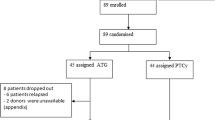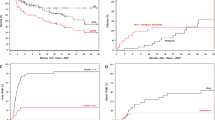Abstract
Fludarabine-based conditioning (FBC) was given to 24 patients and conventional myeloablative conditioning (MC) to 33 patients, most children, before hematopoietic stem cell transplantation (HSCT) for non-malignant diseases. The donors were human leukocyte antigen (HLA)-A, -B, -DRβ1-identical related (33%) or unrelated (67%). In the FBC group, two grafts failed versus three in the MC group; all were successfully regrafted. Fever was more common in the MC patients (P=0.003). Bacteremia occurred in 25% of the FBC group and 50% in the MC group (P=0.1). In the FBC group, platelet engraftment was faster and transfusions were fewer (P<0.05). Mucositis and renal function were similar in the two groups. The MC group had higher maximum bilirubin (P=0.03) and less often normal spirometry (P=0.04) after HSCT. A 7-year-old girl in the MC group had permanent alopecia. No patients had severe acute graft-versus-host disease (GVHD). Chronic GVHD was rare. Complete donor CD3+ chimerism was more common in the MC group (P=0.01), but CD33+ engraftment was better with FBS (P=0.03). Treatment-related mortality was 4 and 15%, and 5-year survival was 89 and 85% in the FBC and MC groups. Although survival was similar, FBC is a promising alternative to MC in non-malignant disorders.
This is a preview of subscription content, access via your institution
Access options
Subscribe to this journal
Receive 12 print issues and online access
$259.00 per year
only $21.58 per issue
Buy this article
- Purchase on Springer Link
- Instant access to full article PDF
Prices may be subject to local taxes which are calculated during checkout

Similar content being viewed by others
References
Giralt S, Estey E, Albitar M, van Besien K, Rondon G, Anderlini P et al. Engraftment of allogeneic hematopoietic progenitor cells with purine analog-containing chemotherapy: harnessing graft-versus-leukemia without myeloablative therapy. Blood 1997; 89: 4531–4536.
McSweeney PA, Niederwieser D, Shizuru JA, Sandmaier BM, Molina AJ, Maloney DG et al. Hematopoietic cell transplantation in older patients with hematologic malignancies: replacing high-dose cytotoxic therapy with graft-versus-tumor effects. Blood 2001; 97: 3390–3400.
Slavin S, Nagler A, Naparstek E, Kapelushnik Y, Aker M, Cividalli G et al. Nonmyeloablative stem cell transplantation and cell therapy as an alternative to conventional bone marrow transplantation with lethal cytoreduction for the treatment of malignant and nonmalignant hematologic diseases. Blood 1998; 91: 756–763.
O'Reilly RJ, Kapoor N, Kirkpatrick D, Flomenberg N, Pollack MS, Dupont B et al. Transplantation of hematopoietic cells for lethal congenital immunodeficiencies. Birth Defects Orig Artic Ser 1983; 19: 129–137.
Peters C, Steward CG . Hematopoietic cell transplantation for inherited metabolic diseases: an overview of outcomes and practice guidelines. Bone Marrow Transplant 2003; 31: 229–239.
Storb R, Etzioni R, Anasetti C, Appelbaum FR, Buckner CD, Bensinger W et al. Cyclophosphamide combined with antithymocyte globulin in preparation for allogeneic marrow transplants in patients with aplastic anemia. Blood 1994; 84: 941–949.
Lucarelli G, Clift RA, Galimberti M, Polchi P, Angelucci E, Baronciani D et al. Marrow transplantation for patients with thalassemia: results in class 3 patients. Blood 1996; 87: 2082–2088.
Niederwieser D, Maris M, Shizuru JA, Petersdorf E, Hegenbart U, Sandmaier BM et al. Low-dose total body irradiation (TBI) and fludarabine followed by hematopoietic cell transplantation (HCT) from HLA-matched or mismatched unrelated donors and postgrafting immunosuppression with cyclosporine and mycophenolate mofetil (MMF) can induce durable complete chimerism and sustained remissions in patients with hematological diseases. Blood 2003; 101: 1620–1629.
Bitan M, Or R, Shapira MY, Aker M, Resnick IB, Ackerstein A et al. Fludarabine-based reduced intensity conditioning for stem cell transplantation of Fanconi anemia patients from fully matched related and unrelated donors. Biol Blood Marrow Transplant 2006; 12: 712–718.
Del Toro G, Satwani P, Harrison L, Cheung YK, Brigid BM, George D et al. A pilot study of reduced intensity conditioning and allogeneic stem cell transplantation from unrelated cord blood and matched family donors in children and adolescent recipients. Bone Marrow Transplant 2004; 33: 613–622.
Fukano R, Nagatoshi Y, Shinkoda Y, Saito Y, Takahashi D, Hatanaka M et al. Unrelated bone marrow transplantation using a reduced-intensity conditioning regimen for the treatment of Kostmann syndrome. Bone Marrow Transplant 2006; 38: 635–636.
Horwitz ME, Barrett AJ, Brown MR, Carter CS, Childs R, Gallin JI et al. Treatment of chronic granulomatous disease with nonmyeloablative conditioning and a T-cell-depleted hematopoietic allograft. N Engl J Med 2001; 344: 881–888.
Jacobsohn DA, Duerst R, Tse W, Kletzel M . Reduced intensity haemopoietic stem-cell transplantation for treatment of non-malignant diseases in children. Lancet 2004; 364: 156–162.
Kikuta A, Ito M, Mochizuki K, Akaihata M, Nemoto K, Sano H et al. Nonmyeloablative stem cell transplantation for nonmalignant diseases in children with severe organ dysfunction. Bone Marrow Transplant 2006; 38: 665–669.
Rao K, Amrolia PJ, Jones A, Cale CM, Naik P, King D et al. Improved survival after unrelated donor bone marrow transplantation in children with primary immunodeficiency using a reduced-intensity conditioning regimen. Blood 2005; 105: 879–885.
Cesaro S . Will a reduced-toxicity conditioning regimen improve the results of stem cell transplantation in metabolic disease? Bone Marrow Transplant 2006; 37: 615.
Ringden O, Svenberg P, Le Blanc K, Mattsson J, Remberger M . Myeloablative conditioning for hematopoietic stem-cell transplantation in patients with non-malignant diseases. Bone Marrow Transplant 2006; 38: 321–322.
Olerup O, Zetterquist H . HLA-DR typing by PCR amplification with sequence-specific primers (PCR-SSP) in 2 h: an alternative to serological DR typing in clinical practice including donor-recipient matching in cadaveric transplantation. Tissue Antigens 1992; 39: 225–235.
Ringden O, Remberger M, Runde V, Bornhauser M, Blau IW, Basara N et al. Peripheral blood stem cell transplantation from unrelated donors: a comparison with marrow transplantation. Blood 1999; 94: 455–464.
Aker M, Varadi G, Slavin S, Nagler A . Fludarabine-based protocol for human umbilical cord blood transplantation in children with Fanconi anemia. J Pediatr Hematol Oncol 1999; 21: 237–239.
Shaw PJ, Hugh-Jones K, Hobbs JR, Downie CJ, Barnes R . Busulphan and cyclophosphamide cause little early toxicity during displacement bone marrow transplantation in fifty children. Bone Marrow Transplant 1986; 1: 193–200.
Storb R, Deeg HJ, Fisher L, Appelbaum F, Buckner CD, Bensinger W et al. Cyclosporine v methotrexate for graft-v-host disease prevention in patients given marrow grafts for leukemia: long-term follow-up of three controlled trials. Blood 1988; 71: 293–298.
Svahn BM, Remberger M, Myrback KE, Holmberg K, Eriksson B, Hentschke P et al. Home care during the pancytopenic phase after allogeneic hematopoietic stem cell transplantation is advantageous compared with hospital care. Blood 2002; 100: 4317–4324.
Mattsson J, Uzunel M, Tammik L, Aschan J, Ringden O . Leukemia lineage-specific chimerism analysis is a sensitive predictor of relapse in patients with acute myeloid leukemia and myelodysplastic syndrome after allogeneic stem cell transplantation. Leukemia 2001; 15: 1976–1985.
Ljungman P, Aschan J, Lewensohn-Fuchs I, Carlens S, Larsson K, Lonnqvist B et al. Results of different strategies for reducing cytomegalovirus-associated mortality in allogeneic stem cell transplant recipients. Transplantation 1998; 66: 1330–1334.
Ruutu T, Eriksson B, Remes K, Juvonen E, Volin L, Remberger M et al. Ursodeoxycholic acid for the prevention of hepatic complications in allogeneic stem cell transplantation. Blood 2002; 100: 1977–1983.
Ringden O, Remberger M, Ruutu T, Nikoskelainen J, Volin L, Vindelov L et al. Increased risk of chronic graft-versus-host disease, obstructive bronchiolitis, and alopecia with busulfan versus total body irradiation: long-term results of a randomized trial in allogeneic marrow recipients with leukemia. Nordic Bone Marrow Transplantation Group. Blood 1999; 93: 2196–2201.
Remberger M, Storer B, Ringden O, Anasetti C . Association between pretransplant thymoglobulin and reduced non-relapse mortality rate after marrow transplantation from unrelated donors. Bone Marrow Transplant 2002; 29: 391–397.
Ringden O, Barrett AJ, Zhang MJ, Loberiza FR, Bolwell BJ, Cairo MS et al. Decreased treatment failure in recipients of HLA-identical bone marrow or peripheral blood stem cell transplants with high CD34 cell doses. Br J Haematol 2003; 121: 874–885.
Ringden O, Remberger M, Svahn BM, Barkholt L, Mattsson J, Aschan J et al. Allogeneic hematopoietic stem cell transplantation for inherited disorders: experience in a single center. Transplantation 2006; 81: 718–725.
Gluckman E, Pasquini R, Rocha V, Harris R, Locatelli F . Results of unrelated cord blood transplants in Fanconi anemia. Blood 2003; 102, abstract 859.
Garwicz S, Anderson H, Olsen JH, Dollner H, Hertz H, Jonmundsson G et al. Second malignant neoplasms after cancer in childhood and adolescence: a population-based case-control study in the 5 Nordic countries. The Nordic Society for Pediatric Hematology and Oncology. The Association of the Nordic Cancer Registries. Int J Cancer 2000; 88: 672–678.
Acknowledgements
We thank the staff for compassionate and competent patient care. Inger Hammarberg is acknowledged for skilful preparation of this paper. Supported by grants from the Swedish Cancer Society (0070-B05-19XAC), the Children's Cancer Foundation (03/039), the Swedish Research Council (K2006-32X-05971-26-1), the Cancer Society in Stockholm, the Cancer- and Allergy Foundation, and Karolinska Institutet.
Author information
Authors and Affiliations
Corresponding author
Rights and permissions
About this article
Cite this article
Ringdén, O., Remberger, M., Svenberg, P. et al. Fludarabine-based disease-specific conditioning or conventional myeloablative conditioning in hematopoietic stem cell transplantation for treatment of non-malignant diseases. Bone Marrow Transplant 39, 383–388 (2007). https://doi.org/10.1038/sj.bmt.1705602
Received:
Revised:
Accepted:
Published:
Issue Date:
DOI: https://doi.org/10.1038/sj.bmt.1705602
Keywords
This article is cited by
-
Cytokine levels following allogeneic hematopoietic cell transplantation: a match-pair analysis of home care versus hospital care
International Journal of Hematology (2021)
-
Management of adult patients older than 40 years refractory to at least one immunosuppressive course: HLA-identical sibling HSCT using fludarabine-based conditioning
Bone Marrow Transplantation (2013)
-
Increasing mixed chimerism and the risk of graft loss in children undergoing allogeneic hematopoietic stem cell transplantation for non-malignant disorders
Bone Marrow Transplantation (2008)



